 Sara Pozzi, Professor, Nuclear Engineering and Radiological Sciences and Consortium Director of the Consortium for Verification Technology, runs a sample through a plutonium and uranium detector in the Nuclear Engineering Laboratory. The detector uses a scattered array analysis, detecting uranium and plutonium particles through nuclear fission reactions generated between the detector and the test sample. Photo: Joseph Xu
Sara Pozzi, Professor, Nuclear Engineering and Radiological Sciences and Consortium Director of the Consortium for Verification Technology, runs a sample through a plutonium and uranium detector in the Nuclear Engineering Laboratory. The detector uses a scattered array analysis, detecting uranium and plutonium particles through nuclear fission reactions generated between the detector and the test sample. Photo: Joseph Xu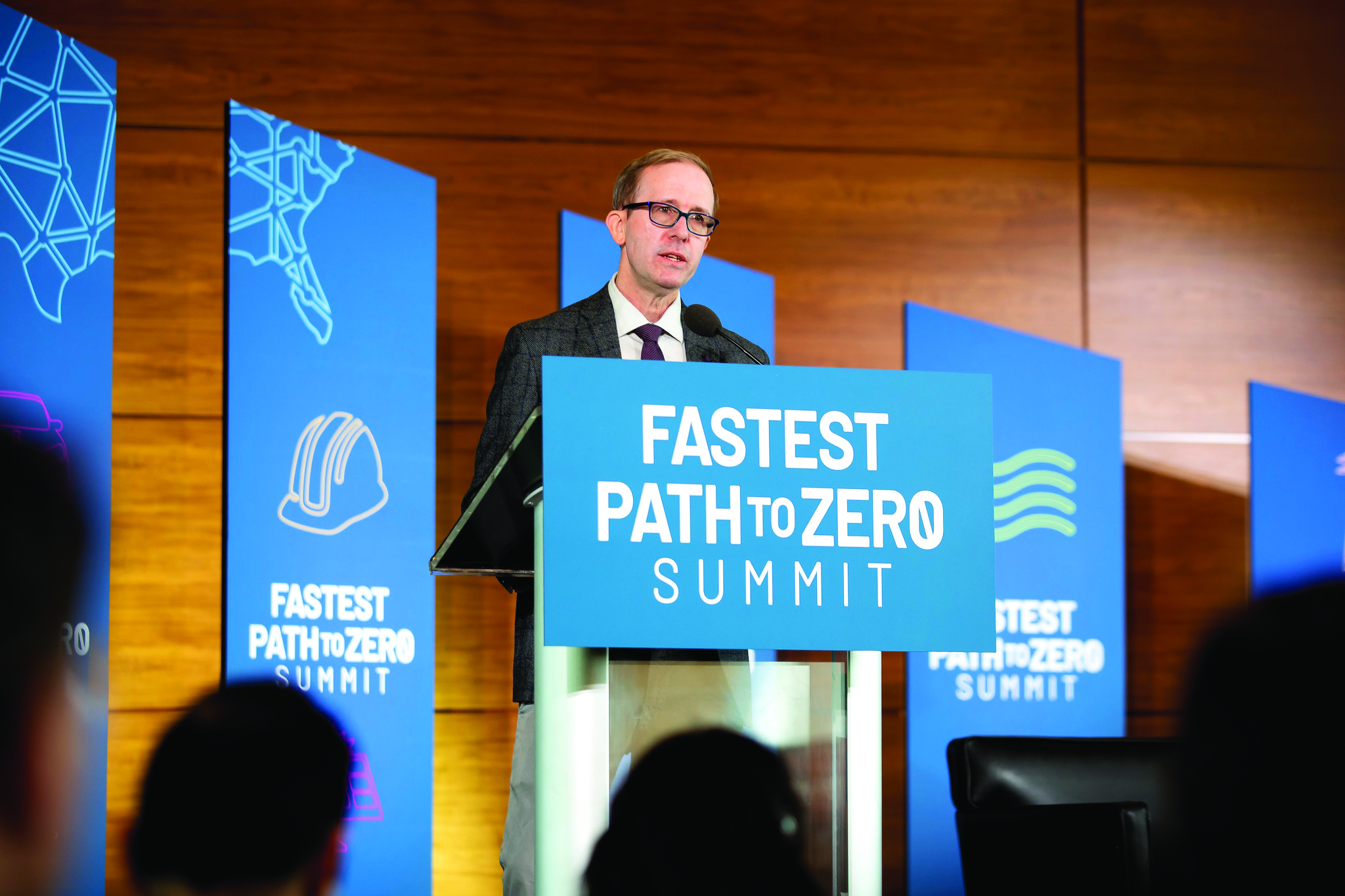 Todd Allen, Glenn F and Gladys H Knoll Department Chair of Nuclear Engineering and Radiological Sciences, Chair, Department of Nuclear Engineering and Radiological Sciences and Professor of Nuclear Engineering and Radiological Sciences, speaks at the Fastest Path to Zero Summit at the Ross School of Business on Central Campus of the University of Michigan in Ann Arbor, MI on April 8, 2019. Photo: Joseph Xu/Michigan Engineering, Communications & Marketing
Todd Allen, Glenn F and Gladys H Knoll Department Chair of Nuclear Engineering and Radiological Sciences, Chair, Department of Nuclear Engineering and Radiological Sciences and Professor of Nuclear Engineering and Radiological Sciences, speaks at the Fastest Path to Zero Summit at the Ross School of Business on Central Campus of the University of Michigan in Ann Arbor, MI on April 8, 2019. Photo: Joseph Xu/Michigan Engineering, Communications & Marketing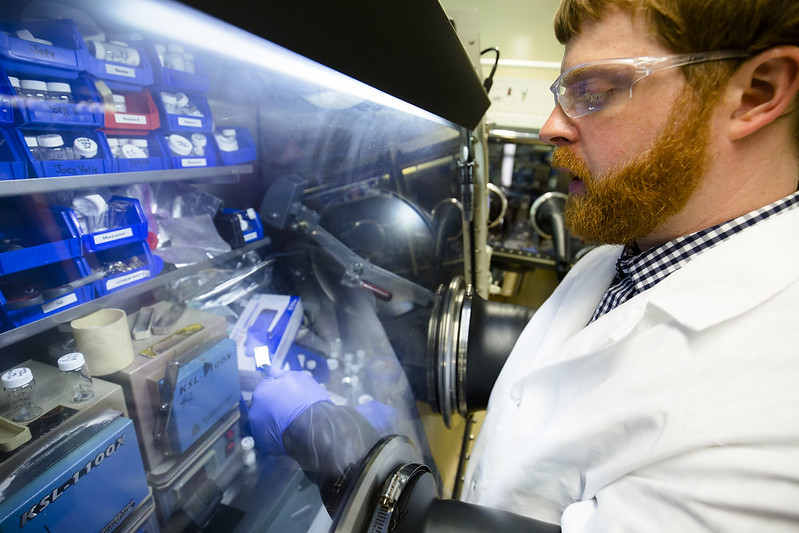 Nathan Taylor, a post-doctoral fellow in mechanical engineering, inspects a piece of lithium metal in the Michigan Memorial Phoenix Project. Taylor works in the lab of Jeff Sakamoto, professor of mechanical engineering. Their team has developed a process for creating lithium metal solid state batteries with LLZO as an electrolyte that could drastically improve upon the performance and capacity of current lithium-ion battery technologies.
Nathan Taylor, a post-doctoral fellow in mechanical engineering, inspects a piece of lithium metal in the Michigan Memorial Phoenix Project. Taylor works in the lab of Jeff Sakamoto, professor of mechanical engineering. Their team has developed a process for creating lithium metal solid state batteries with LLZO as an electrolyte that could drastically improve upon the performance and capacity of current lithium-ion battery technologies.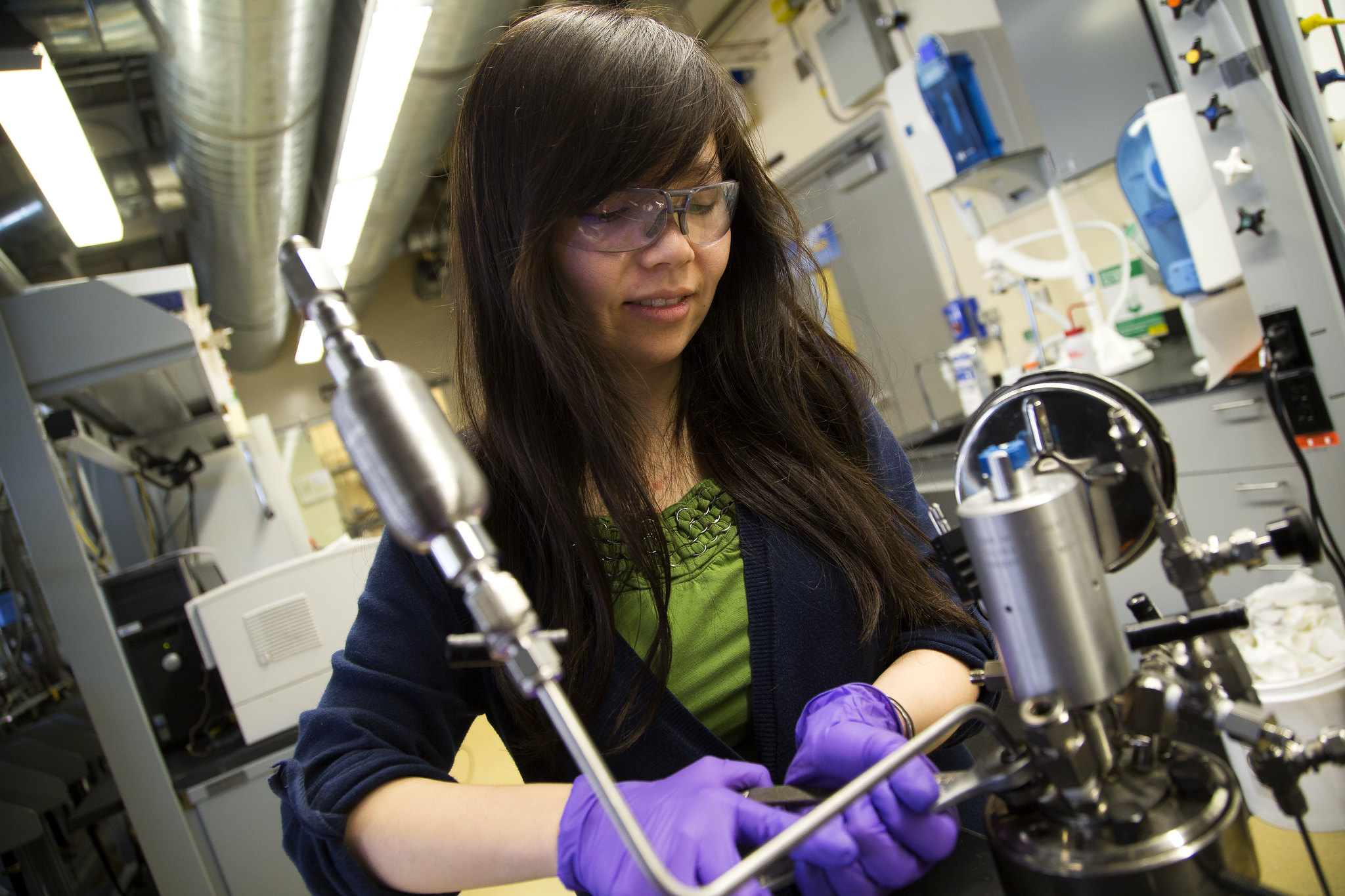 Yuan Chen, ChE PhD Student, works on a carbon dioxide pump in the MMPP. Photo: Joseph Xu
Yuan Chen, ChE PhD Student, works on a carbon dioxide pump in the MMPP. Photo: Joseph Xu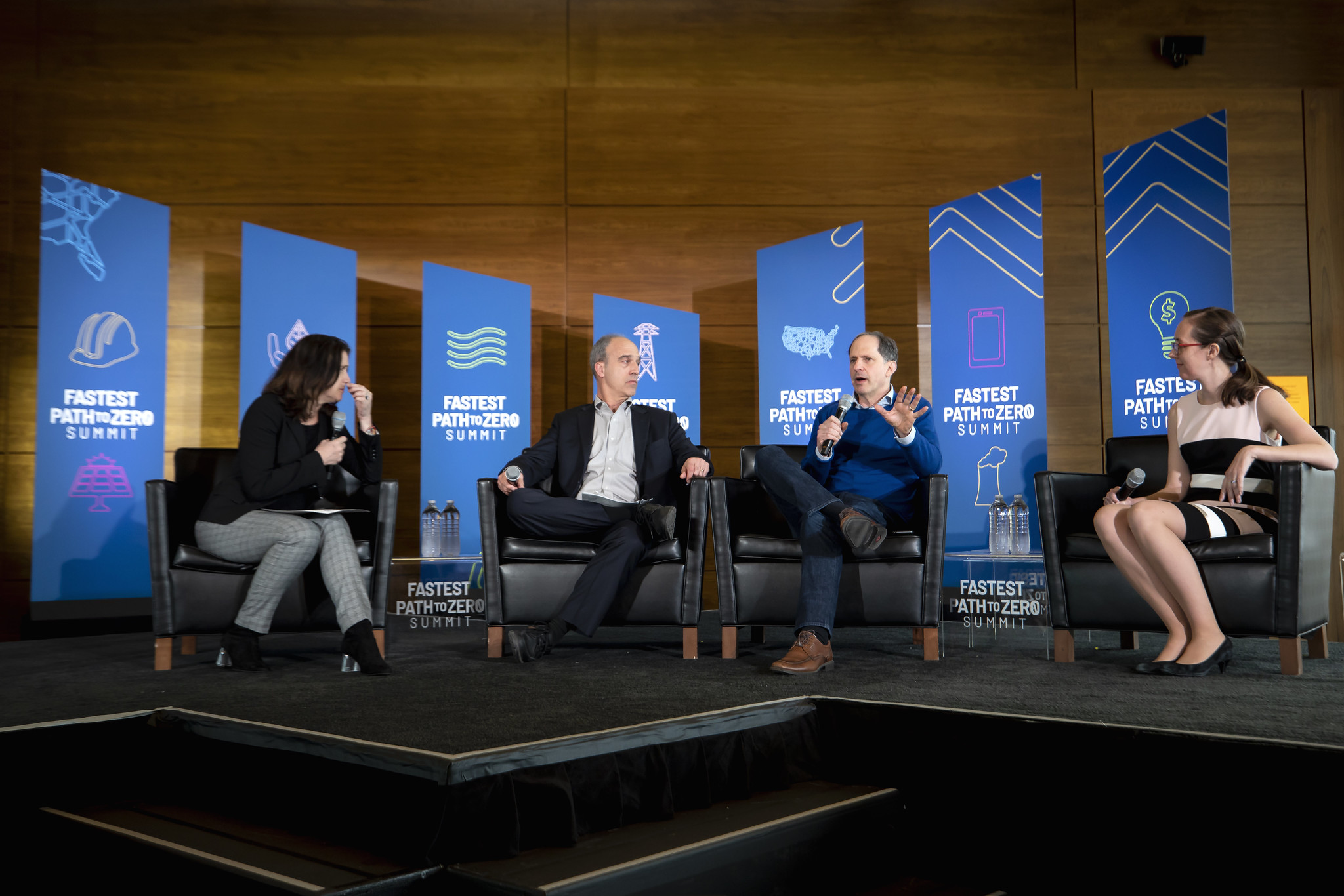 Dominique Broussard, University of Wisconsin, hosts a panel detailing what the fastest path to zero emissions might be with Ken Kimmell, Union of Concerned Scientists. Armond Cohen, Clean Air Task Force, and Catie Hausman, Assistant Professor of Public Policy, Gerald R Ford School of Public Policy, at the Fastest Path to Zero Summit at the Ross School of Business on Central Campus of the University of Michigan in Ann Arbor, MI on April 8, 2019. Photo: Joseph Xu/Michigan Engineering, Communications & Marketing
Dominique Broussard, University of Wisconsin, hosts a panel detailing what the fastest path to zero emissions might be with Ken Kimmell, Union of Concerned Scientists. Armond Cohen, Clean Air Task Force, and Catie Hausman, Assistant Professor of Public Policy, Gerald R Ford School of Public Policy, at the Fastest Path to Zero Summit at the Ross School of Business on Central Campus of the University of Michigan in Ann Arbor, MI on April 8, 2019. Photo: Joseph Xu/Michigan Engineering, Communications & Marketing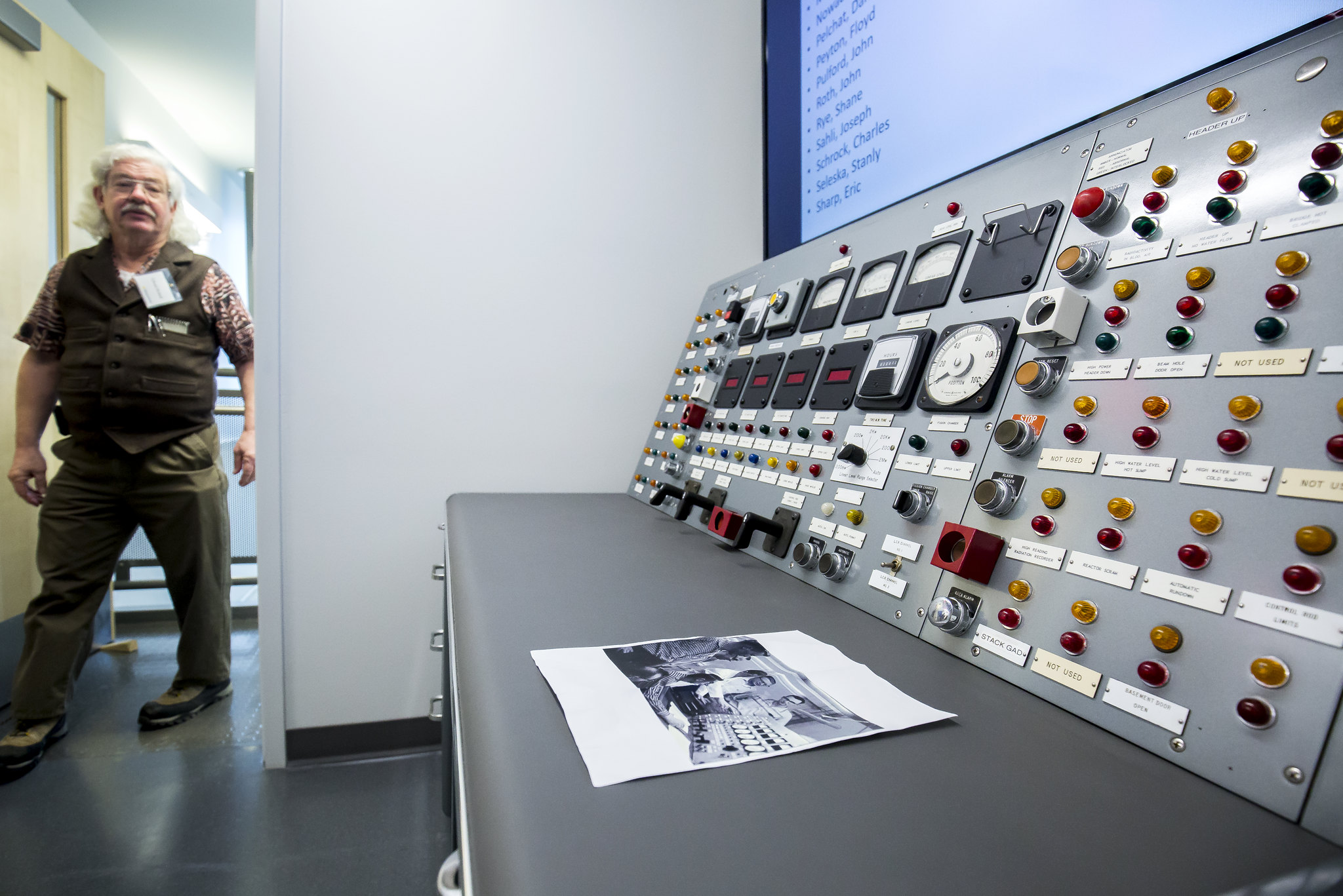 The original Ford Reactor console installed in the new Nuclear Engineering Laboratory at its grand opening ceremony on North Campus of the University of Michigan in Ann Arbor, MI on April 3, 2016. Photo: Joseph Xu/Multimedia Content Producer, University of Michigan - College of Engineering
The original Ford Reactor console installed in the new Nuclear Engineering Laboratory at its grand opening ceremony on North Campus of the University of Michigan in Ann Arbor, MI on April 3, 2016. Photo: Joseph Xu/Multimedia Content Producer, University of Michigan - College of Engineering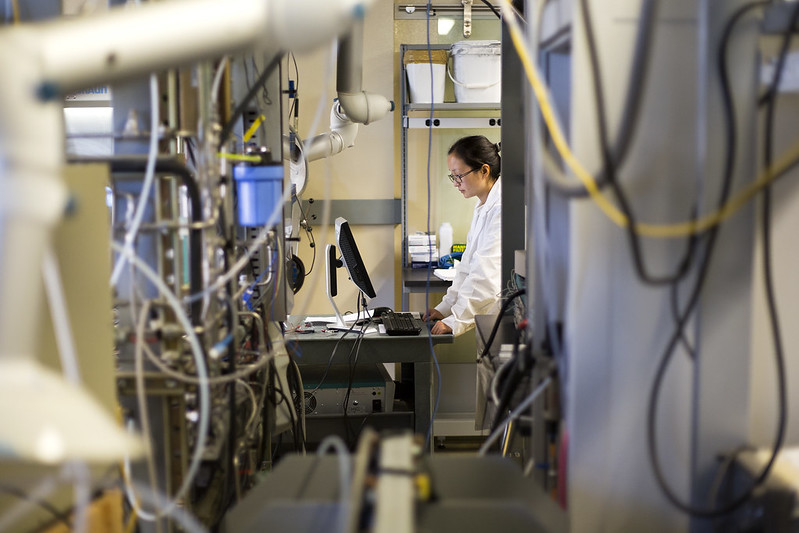 Xingyi Yang, ChE Research Fellow, tests a battery cell in Battery Lab. Photo: Joseph Xu
Xingyi Yang, ChE Research Fellow, tests a battery cell in Battery Lab. Photo: Joseph Xu Xingyi Yang, ChE Research Fellow, works on constructing a battery cell. Photo: Joseph Xu
Xingyi Yang, ChE Research Fellow, works on constructing a battery cell. Photo: Joseph Xu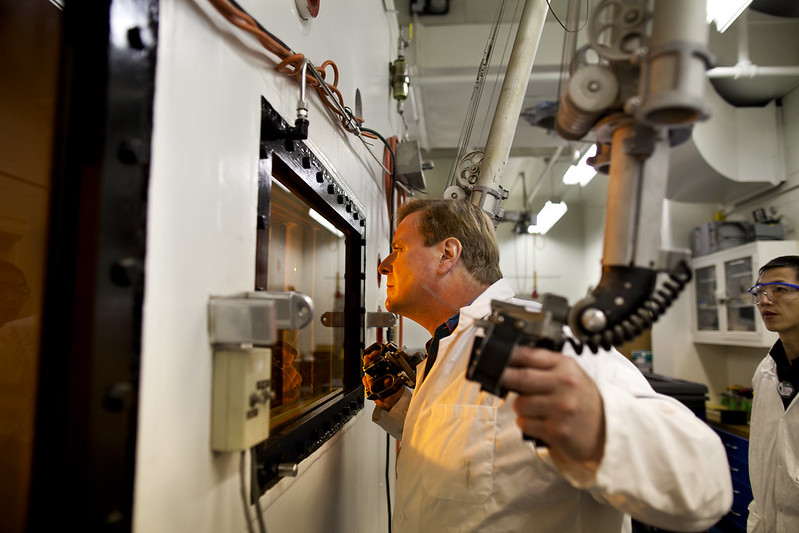 The hot cell allows researchers to safely work with highly radioactive materials by blocking the radiation. Its walls are made of high density concrete, three feet thick, with equally thick windows of leaded glass. Robotic arms dating to 1958 allow Assistant Reactor Manager and retiree Phil Simpson to manipulate a radioactive sample the size of a thick nickel. He is in the process of welding six platinum wires coated in white zirconia onto the sample for experiments. The experiments take place in the Irradiated Material Laboratory next door, where the sample is exposed to high temperatures and mechanical stress to simulate conditions inside a nuclear reactor. Assistant Research Scientist Yugo Ashida, who runs experiments in the Irradiated Material Laboratory, looks on. Photo: Joseph Xu
The hot cell allows researchers to safely work with highly radioactive materials by blocking the radiation. Its walls are made of high density concrete, three feet thick, with equally thick windows of leaded glass. Robotic arms dating to 1958 allow Assistant Reactor Manager and retiree Phil Simpson to manipulate a radioactive sample the size of a thick nickel. He is in the process of welding six platinum wires coated in white zirconia onto the sample for experiments. The experiments take place in the Irradiated Material Laboratory next door, where the sample is exposed to high temperatures and mechanical stress to simulate conditions inside a nuclear reactor. Assistant Research Scientist Yugo Ashida, who runs experiments in the Irradiated Material Laboratory, looks on. Photo: Joseph Xu A current NERS PhD researcher (left) demonstrates with an ultraviolet light the properties of fluids used as sensors in his labs research, at the NERS Recruiting Bootcamp for prospective graduate students. Photo: Mitchell LaBelle
A current NERS PhD researcher (left) demonstrates with an ultraviolet light the properties of fluids used as sensors in his labs research, at the NERS Recruiting Bootcamp for prospective graduate students. Photo: Mitchell LaBelle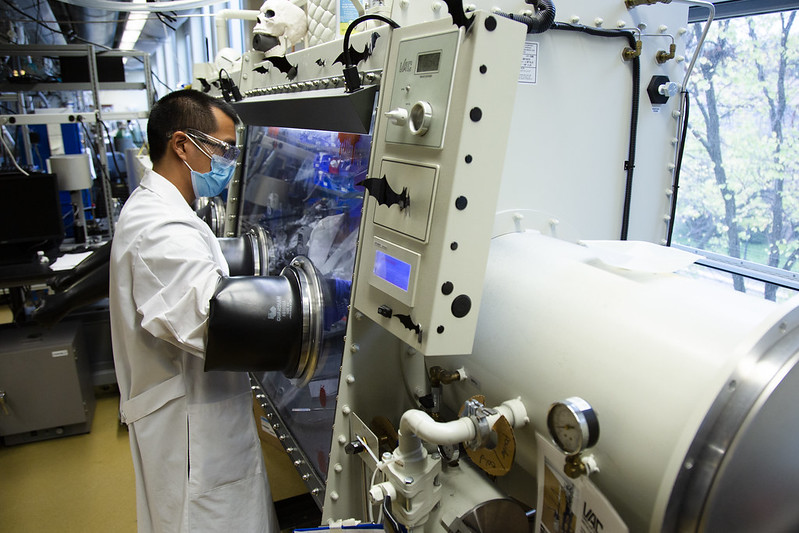 Michael Wang, materials science and engineering Ph.D. candidate, uses a glove box to inspect a lithium metal battery cell. Photo: Evan Dougherty
Michael Wang, materials science and engineering Ph.D. candidate, uses a glove box to inspect a lithium metal battery cell. Photo: Evan Dougherty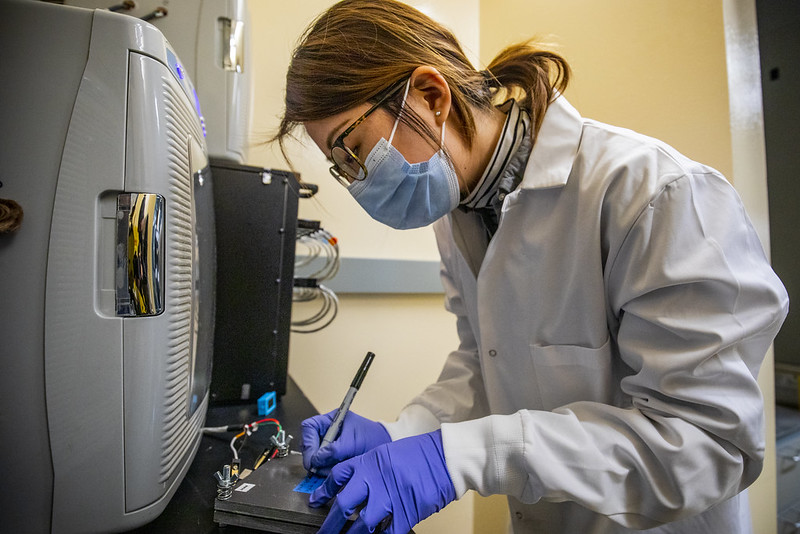 Yuxin Chen, Graduate Student Instructor and Graduate Student Research Assistant in Mechanical Engineering, tries to verify the charge of lithium metal, solid-state batteries which use a solid electrolyte instead of the currently used flammable liquid electrolyte, inside the Battery Fabrication and Characterization User Facility. Photo: Robert Coelius
Yuxin Chen, Graduate Student Instructor and Graduate Student Research Assistant in Mechanical Engineering, tries to verify the charge of lithium metal, solid-state batteries which use a solid electrolyte instead of the currently used flammable liquid electrolyte, inside the Battery Fabrication and Characterization User Facility. Photo: Robert Coelius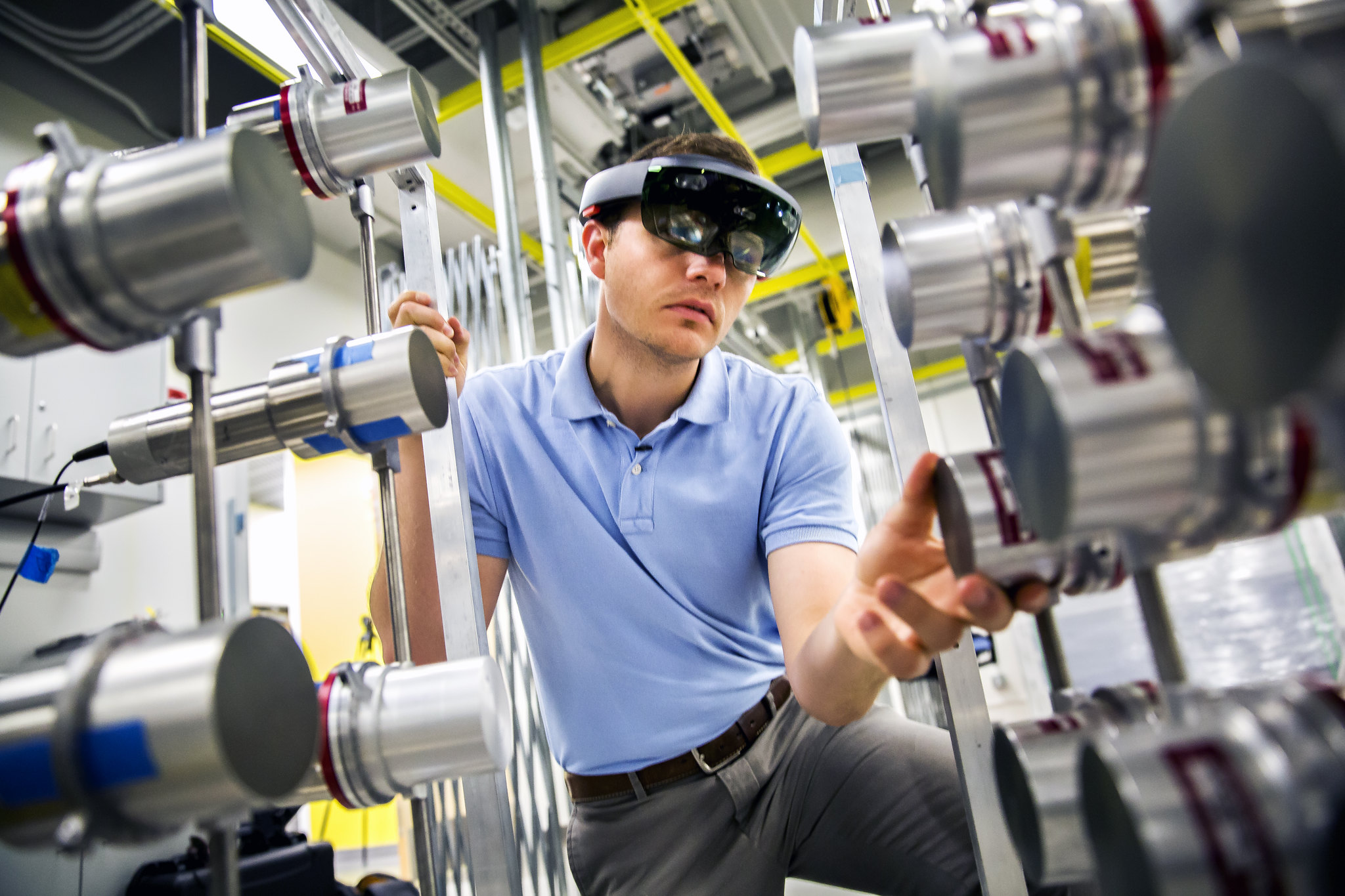 Michael Hamel, NERS PhD Student, uses a Microsoft Hololens headset to demonstrate use of augmented reality to detect the presence of nuclear weapons in the Nuclear Engineering Laboratory on June 21, 2017. The technology is designed by the Consortium for Verification Technology (CVT) led by Sara Pozzi, NERS Professor. The CVT consists of twelve leading universities and nine national laboratories, working together to provide research and development needed to address technology and policy issues in treaty-compliance monitoring of nuclear weapons. Photo: Joseph Xu/Senior Multimedia Content Producer, University of Michigan - College of Engineering
Michael Hamel, NERS PhD Student, uses a Microsoft Hololens headset to demonstrate use of augmented reality to detect the presence of nuclear weapons in the Nuclear Engineering Laboratory on June 21, 2017. The technology is designed by the Consortium for Verification Technology (CVT) led by Sara Pozzi, NERS Professor. The CVT consists of twelve leading universities and nine national laboratories, working together to provide research and development needed to address technology and policy issues in treaty-compliance monitoring of nuclear weapons. Photo: Joseph Xu/Senior Multimedia Content Producer, University of Michigan - College of Engineering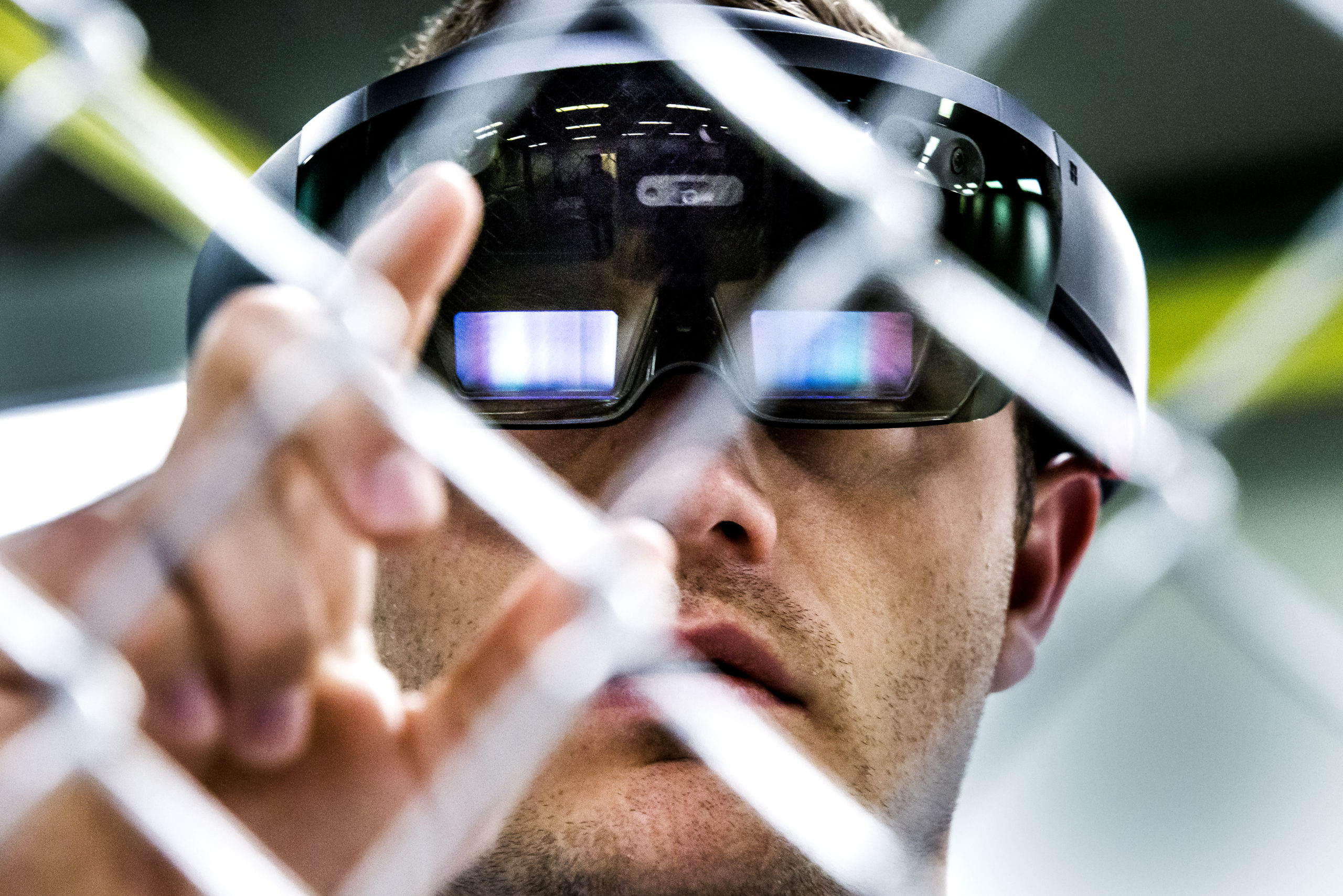 Michael Hamel, NERS PhD Student, uses a Microsoft Hololens headset to demonstrate use of augmented reality to detect the presence of nuclear weapons in the Nuclear Engineering Laboratory on June 21, 2017. The technology is designed by the Consortium for Verification Technology (CVT) led by Sara Pozzi, NERS Professor. The CVT consists of twelve leading universities and nine national laboratories, working together to provide research and development needed to address technology and policy issues in treaty-compliance monitoring of nuclear weapons. Photo: Joseph Xu/Senior Multimedia Content Producer, University of Michigan - College of Engineering
Michael Hamel, NERS PhD Student, uses a Microsoft Hololens headset to demonstrate use of augmented reality to detect the presence of nuclear weapons in the Nuclear Engineering Laboratory on June 21, 2017. The technology is designed by the Consortium for Verification Technology (CVT) led by Sara Pozzi, NERS Professor. The CVT consists of twelve leading universities and nine national laboratories, working together to provide research and development needed to address technology and policy issues in treaty-compliance monitoring of nuclear weapons. Photo: Joseph Xu/Senior Multimedia Content Producer, University of Michigan - College of Engineering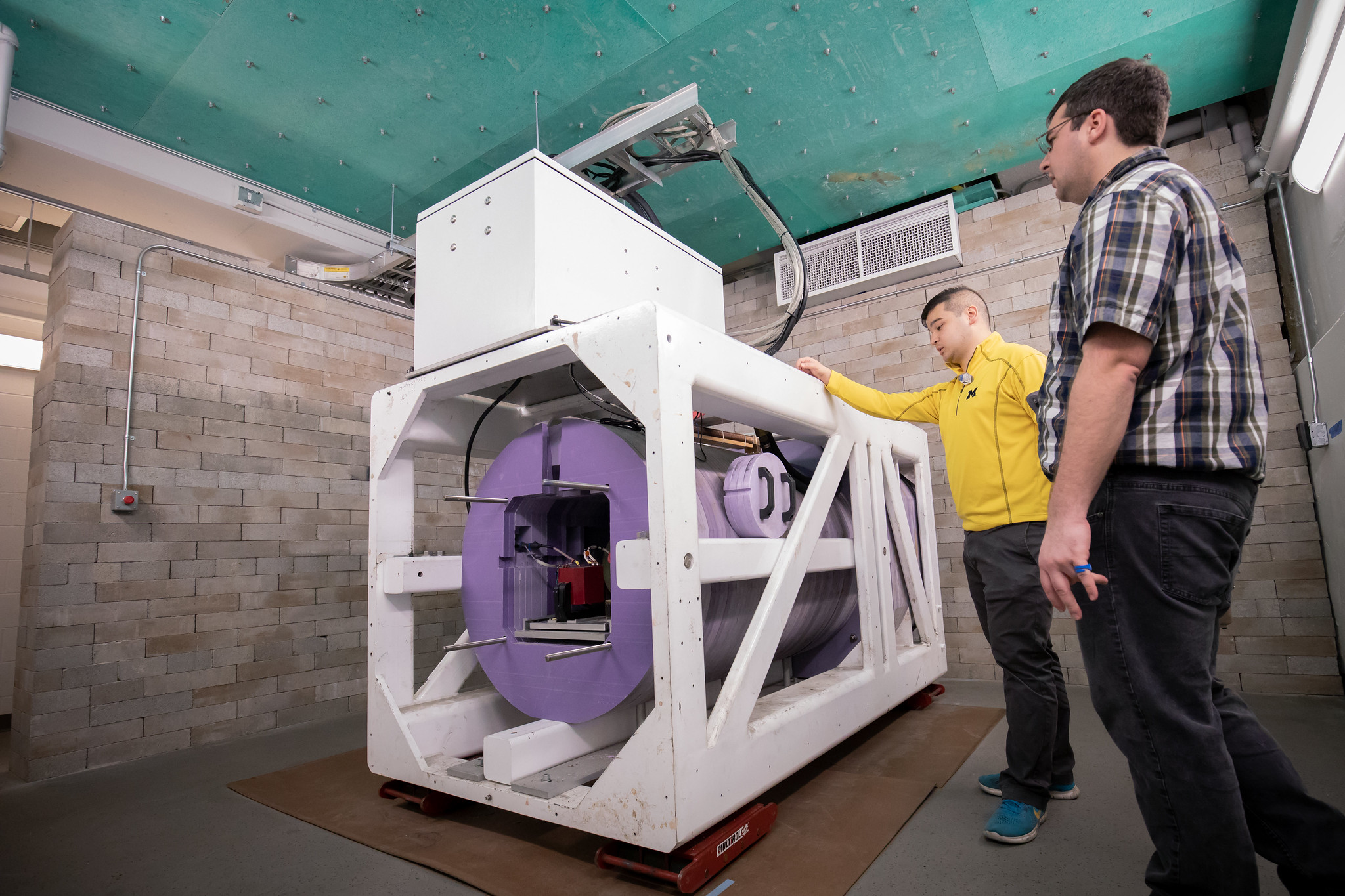 Members of Professor of Nuclear Engineering and Radiological Sciences Sara Pozzi's research group. Photo: Levi Hutmacher
Members of Professor of Nuclear Engineering and Radiological Sciences Sara Pozzi's research group. Photo: Levi Hutmacher
The Michigan Memorial Phoenix Project returns to NERS
NERS News, Published 2021
The World War II memorial is devoted to the peaceful uses of nuclear energy.
“Renovated nuclear reactor building opens as world-class labs”
Michigan News, April 3, 2017
More than a decade after the Ford Nuclear Reactor shut down for the last time, the building comes back to life today as the Nuclear Engineering Laboratory.